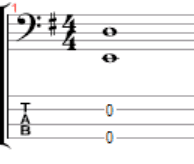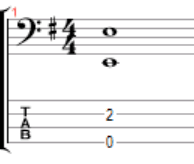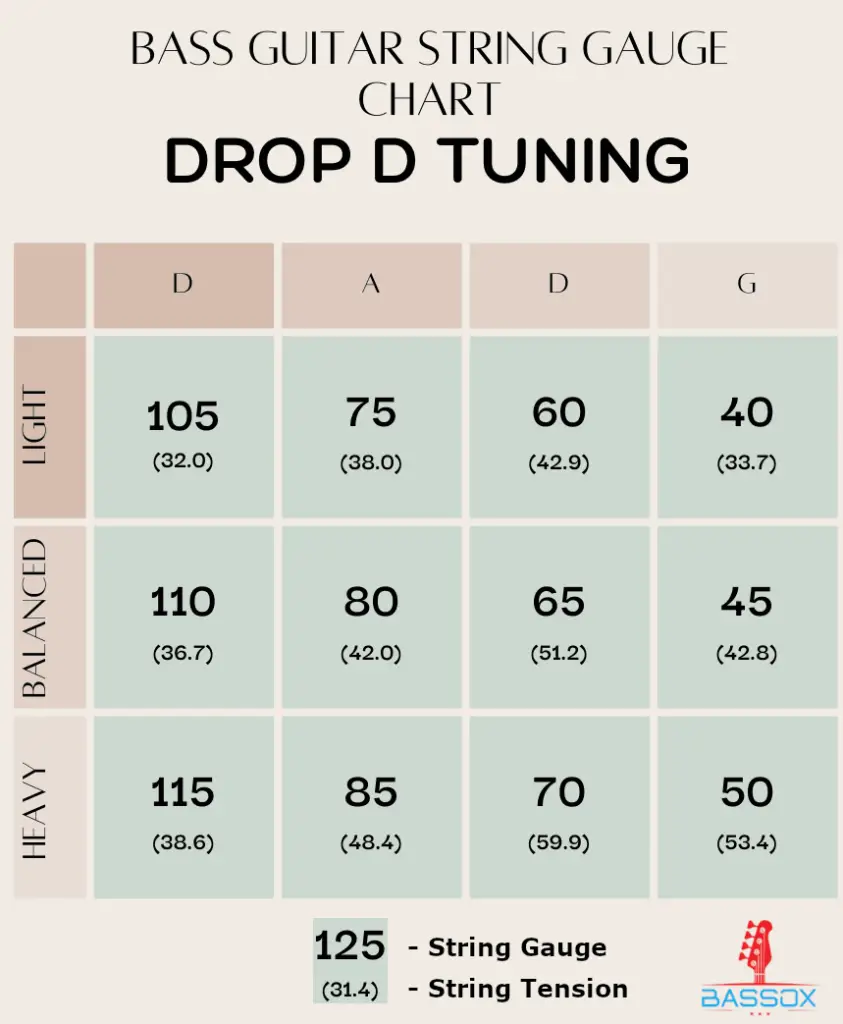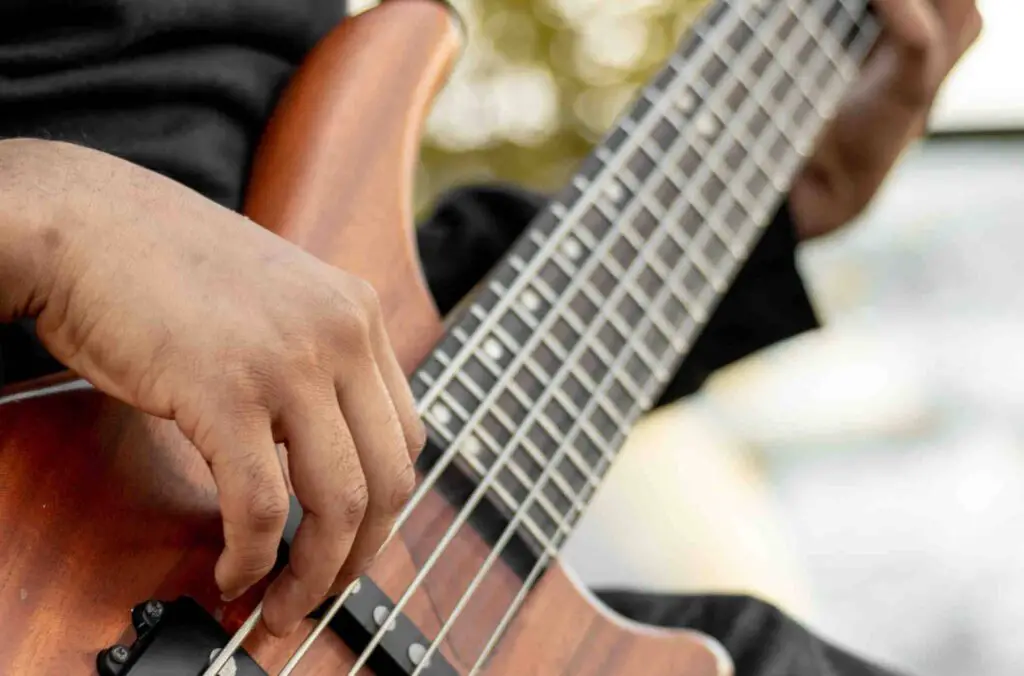This post contains affiliate links.
Drop D is a common alternate bass tuning, and for a good reason. It’s convenient to tune to, it doesn`t require you to set up your bass, and there are plenty of bands to cover.
After playing in various metal bands, I`ve used drop D on multiple occasions. It’s a great tuning, especially for bands that are exploring heavier genres for the first time. However, there are several differences between playing in a standard and a drop tuning that beginners often overlook.
Therefore, I`m here to tell you everything you need to know about Drop D as a bass player.
You will learn how to approach tuning and playing in Drop D on both 4-string and 5-string basses. There is also a tuner below that you can use to easily tune your bass down.
I`ll also cover why you’d choose the tuning over other alternatives, and why you wouldn`t. Lastly, I will show you some examples of bands that play in Drop D, and explain how string choice matters when switching from playing in E standard to drop D.
What is Drop D tuning on bass?
When a bass is tuned to Drop D, the strings are tuned D-A-D-G. This means that the deepest string is dropped 1 whole step down from E standard. Bass players generally tune to drop D to sound heavier and to play in the same tuning as the guitar players in their band.
If you are used to playing in E standard, Drop D will take a little bit of getting used to. This is because the strings will no longer be tuned at perfect 4th intervals. Instead, The D and A strings are now tuned a perfect 5th apart instead.
This means you will have to rethink how you approach the fretboard when switching between the D and A strings. However, once you have learned how to approach the tuning, Drop D opens up new ways to play deep grooves and heavy riffs.
Here are some of the main reasons bassist tune to Drop D:
- Being in synch with the guitars – Drop tunings are loved by guitarists in heavy genres. This is because these tunings make power chords significantly easier to play. While you are unlikely to play deep power chords on the bass, it is convenient for everyone in a band to play in the same tuning.
- Heavier sound – Most bands that play in drop D do so in order to sound heavier. Dropping the E string to D enables you to play deeper, which can be utilized to write riffs that sound heavier. Therefore, this tuning is a staple in metal and hard rock.
- Flexibility – Switching between E standard and Drop D is fast and easy. Thus, it’s a great tuning for adding variety to a band’s catalog, without needing several basses on deck.
- Accommodating the vocalist – Occasionally, a band will tune down to accommodate a vocalist with a deep vocal range. Drop D allows bassists to do this easily without having to tune down all of their strings.

How do I tune my bass to Drop D?
A bass guitar tuned to E standard can be tuned to Drop D by tuning the deepest string from E to D. You can do so by matching the pitch of your deepest string to that of your high D string. Despite being an octave apart the two strings will sound harmonious when both are tuned to D.

This is a simple trick for tuning from E Standard to Drop D and back. Simply play the two notes above and tune the thickest string on your bass down until these two notes sound perfectly in tune.
To get back to E standard. Tune the thickest string up until it is perfectly in tune with the 2nd fret of the D string:

Alternatively, you can make use of the tuner below to tune a 4-string bass to Drop D.
Tuning a 5-string bass to Drop D can be a bit more awkward. Thus, I have covered how to approach tuning a 5-string bass to drop D further down this article.
If you struggle to match the pitch by ear, the next best thing is to use a tuner. Chromatic tuners can be used to tune to Drop D, or alternatively, you can use an online tuner with a microphone.
If your microphone struggles to pick up your sound, play the 12th fret instead of the open string. This is the octave and it is the same pitch as the open string.
What bands use Drop D tuning?
While Drop D is most commonly used by metal bassits, the tuning has been used in a wide range of genres.
Below I`ve compiled a list of some of the most well-known bands that have used this tuning at some point. Some bands, such as Pink Floyd and Red Hot Chili Peppers have used the tuning on a select few songs. Others, such as Billy Talent and Tool have used the tuning consistently.
| Band | Bassist | Genre | Notable songs in Drop D |
| Foo Fighters | Nate Mendel | Rock | “Everlong”, “Low”, “Good Grief” |
| Three Days Grace | Brad Walst | Rock | “Never Too Late”, “Born Like This”, “Break” |
| Tool | Justin Chancellor | Progressive Metal | “Schism”, “Sober”, “Forty Six & 2” |
| Billy Talent | Jonathan Gallant | Rock | “Fallen Leaves”, “Surrender”, “Try Honesty” |
| Opeth | Martín Méndez | Progressive Metal | “Demon Of The Fall”, “The Grand Conjuration”, “Blackwater Park” |
| Fall Out Boy | Pete Wentz | Alternative Rock | “Sugar We’re Going Down”, “Dance, Dance”, “Thriller” |
| Rammstein | Oliver Riedel | Industrial Metal | “Sonne”, “Mutter”, “Engel” |
| Lamb Of God | John Campbell | Death Metal | “Laid To Rest”, “Walk With Me In Hell”, “Omerta” |
| Red Hot Chili Peppers | Flea | Funk | “Naked In The Rain”, “By The Way” |
| Pink Floyd | Roger Waters (til 1985) | Progressive Rock | “Another Brick In The Wall Part 2 “, “Careful With That Axe, Eugene”, “In The Flesh” |
What bass strings should I use for Drop D tuning?
For a balanced set of bass strings for drop D, use strings with gauges of 45-65-80-110. In general, the deepest string will feel too loose if the string is 105 or lighter. For the A, D, and G strings, any string gauge that works for E standard will work for Drop D as well.
Drop D doesn’t differ too much from E standard. After all, you are just tuning one string down 1 whole step. However, the string gauge of the lowest string on your bass has a big impact on your overall tone.
When tuning down, you need to loosen the string to get a deeper pitch. If the lowest string is too loose, it will sound clanky and powerless. It can also feel cumbersome and slow to play.
If you are currently using a regular gauge set intended for E standard, such as 45-65-80-105, you can still tune to Drop D. Your bass will generally sound okay and feel playable. A 45-60-80-100 set will generally also work, though a low 100 gauge string is starting to push the limit.
I go more in-depth about this in my guide to bass string gauges. For the simple version though, here is a chart of tensions for string gauges for Drop D:

With that said, a 110 gauge string will sound more resonant and will help you achieve a heavier tone.
I recommend a 110 D’Addario string, as these are roundwound and thus have a bright and resonant tone that fits heavy genres. They can also be purchased as singles, so you won`t have to get a whole new set of strings.
Drop D vs D Standard tuning for bass
In D Standard every string is tuned a whole step down from E standard. On a 4-string bass, this results in a D-G-C-F tuning.
Drop tunings are often preferred by guitarists because they make it easier to play power chords. This is because the 2 deepest strings can be used to play power chords with just one finger.

The advantage of playing bass in Drop D is thus that you will be more in synch with your guitarists. This is because using the same tuning makes it easier to play riffs without having to transpose them. It also makes it easier to always be on the same page and to share musical ideas.
Riffs will also generally be harder to play in D standard if they are originally written for Drop D. This holds especially true if the riffs utilize the open D string a lot.
The advantage of playing in D standard is that your knowledge of playing in E standard will carry over to D standard. As a result, playing will feel intuitive, as you are playing in the “same tuning”, just 1 whole step deeper.
D standard and drop D have the same low range. Drop D has one whole step higher range, which can be useful in rare cases.

Can you tune a 5 string bass to drop D?
While a 5-string bass can be tuned to Drop D, this will put a lot of tension on the neck and is an inconvenient solution. It is generally preferable to tune to ADGCF (standard) or ADADG (drop), which will give you the same range as drop D on a 4-string while having an added low A.
It is possible to tune a 5-string bass to D-A-D-G-C. However, this would require you to tune all your strings up as much as a perfect fourth. This would require a much lighter set of strings than what is usually used for 5-strings.
Related reading: Do you need a 5 string bass for metal?
Thus, if I had a 5-string and wanted to play in Drop D, I would tune to either A standard (A-D-G-C-F) or to A-D-A-D-G.
In my opinion, A-D-A-D-G makes the most sense, as this tunes your top 4 strings to drop D like on a 4-string bass. This allows you to play all riffs intended for drop D on a 5-string while having an extra low string if needed.
Conclusion
If you want to dive into the world of alternate bass tunings, Drop D is a great place to start. If you like the sound and feel of it, it is also perfectly fine to stick with it. As listed above, many great bands mainly play in Drop D and have had successful and long-lasting careers doing so.
I do however recommend considering what you want to achieve by tuning down. If you are looking to sound as heavy as possible, you could consider tuning to A standard (ADGC) instead.
If you are looking for a “modern heavy sound”, Drop D will help you achieve this. Still, it`s a good idea to experiment with other tunings to find out which one truly works the best for your music.
Overall, Drop D is one of my favorite tunings and I have used it in various bands. It is beginner-friendly, convenient, and most of all it can sound powerful and heavy when utilized correctly. It`s a tried and true tuning that you can`t go wrong with, regardless of whether you are a pro or a beginner.
Are you looking to sound heavier, but don’t want to deal with the hassle of relearning your fretboard? Then consider tuning to C standard. It serves as a nice middle ground when tuning to A sounds excessively deep, and Drop D isn`t deep enough.

